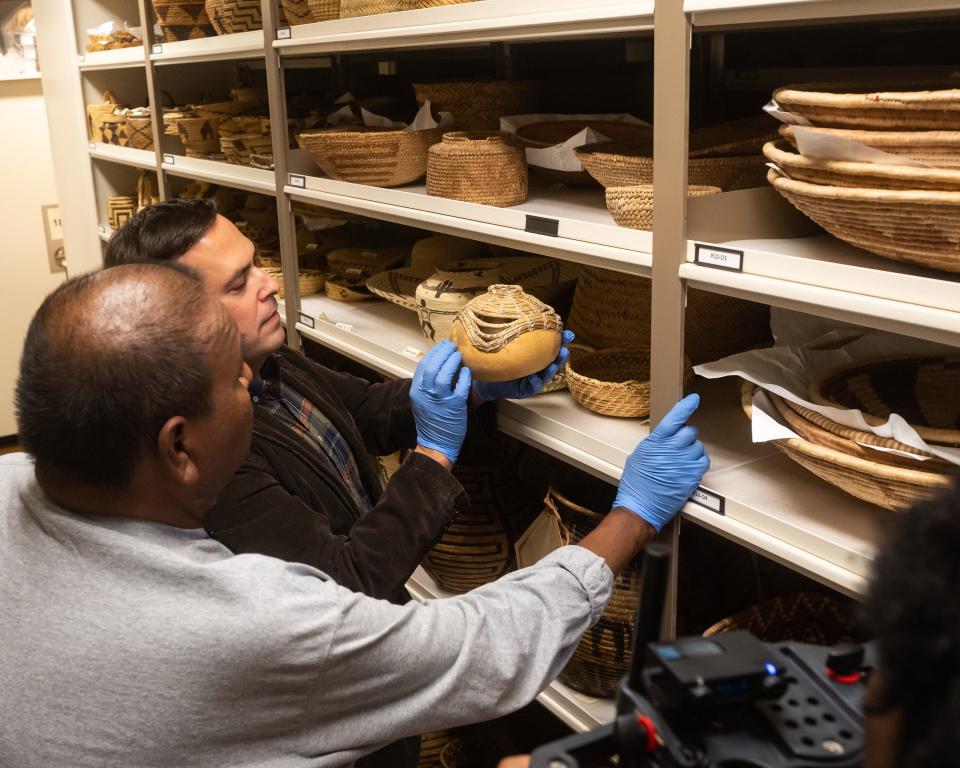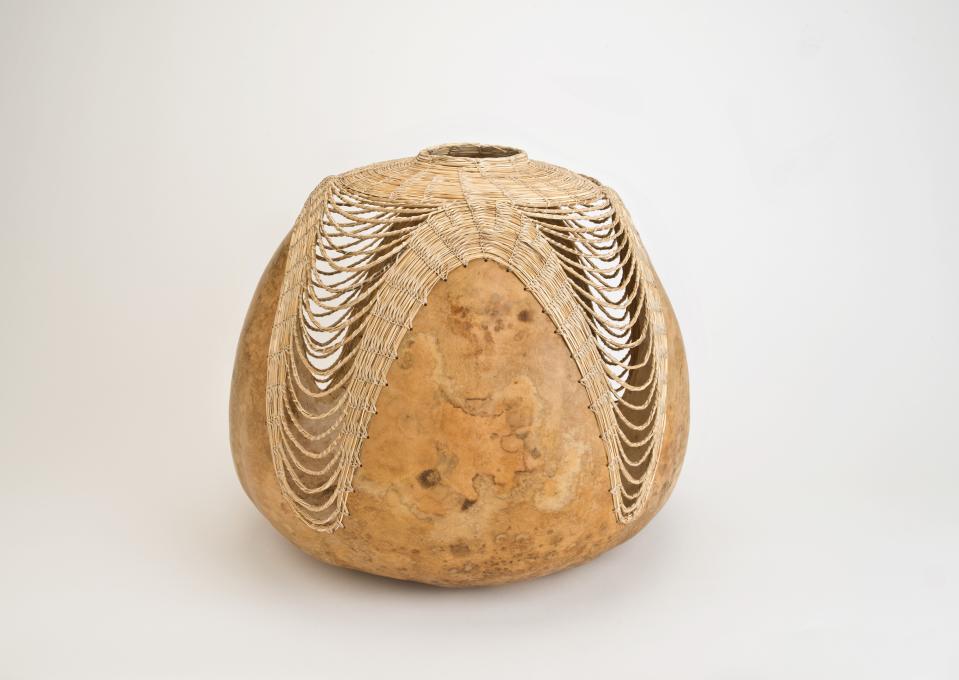Terrol Dew Johnson dies; groundbreaking O'odham basketweaver, traditional foods advocate
- Oops!Something went wrong.Please try again later.
Tohono O'odham basketweaver and cultural practitioner Terrol Dew Johnson was known for his artistry and tenacity in promoting traditional O'odham ways. His many friends also knew him as a generous soul, always willing to share knowledge, willow or snacks with equal aplomb.
The multi-talented artist and activist was showered with accolades, awards and grants for his work ensuring O'odham weavers received fair compensation for their hard work. He also promoted revitalization of traditional — and healthier — traditional foods through community farms and marketing foods grown by O'odham farmers.
Johnson died May 8 at his home in Sells after a long illness. He was 51.
Johnson first started weaving in his late teens, working with O'odham weavers including Clara Havier, who only spoke O’odham. The Arizona Daily Star reported in 2022 that Johnson’s grandparents translated for him as he learned the how-tos of making baskets.
He was also encouraged to come up with his own style. Johnson hit on using gourds, another traditional O'odham material, but instead of making a gourd rattle or other such cultural item, he artistically sliced shapes from large gourds and filled in the empty spaces with woven bear grass or sinew. The edges of the cutouts were often adorned with some of those same materials, or with other plant materials.
Johnson also used both traditional materials like willow, devil's claw and nontraditional materials like wire in his work.

Working to encourage traditional foods
Seeing his family ravaged by diabetes, a disease he was also diagnosed with, Johnson was moved to act. He founded Tohono O'odham Community Action, known as TOCA, in 1996 with his friend, Tristan Reader, who's now a professor at the University of Arizona. The grassroots organization created programs based in the O'odham Himdag, or "People's Way."
TOCA and its sister group, Tohono O'odham Basketweavers Organization, supported fair compensation for weavers, often purchasing baskets directly from weavers and reselling them at a small profit to fund the organization. TOCA also created community gardens and a farm, and marketed items like tepary beans, prickly pear syrup and cholla buds.
He also started a cafe in Sells, which, while open, served up traditional foods.
In the late 1990s, Johnson brought basketweavers together at the Heard Museum for weavers' gatherings. Basketmakers and weavers came from across the continent to weave, sell their items and discuss issues like material access, how to pass on the weaving craft to new generations or, in later events, to prepare and share Native foods. The gathering moved to Tucson in the mid-2000s.
As his reputation for artistry and activism grew, so did the accolades.
Johnson's first major recognition came from the Do Something Foundation in 1999 and the Ford Foundation's Leadership for a Changing World Award in 2002.
In 2010, Johnson walked 3,000 miles from Maine to Arizona in "The Walk Home: A Journey to Native Wellness." The walk aimed to raise awareness of the diabetes crisis in tribal communities and promote how revitalizing cultural traditions can support wellness.
In 2012, Johnson was honored as a Champion of Change by President Barack Obama for his work to revive local foods that support health, economic development and cultural revitalization in the O'odham communities. "Drawing upon the strength of the O’odham Himdag — the Desert People’s Lifeways — we have looked to our heritage to create solutions for tomorrow," he wrote when accepting the award.
His work was honored and featured in exhibits
Even as his health declined, Johnson continued to work and promote other weavers' work. In 2022, the Maxwell/Hanrahan Foundation awarded him $100,000 to continue his career as a steward of cultural traditions, according to a release from the foundation.
In 2023, Johnson was nominated for the Loewe Foundation's Craft Award for his collaborative work with art studio Aranda\Lasch, displayed at the Noguchi Museum in New York.
He also contributed works to the exhibit ‘Amai Mo ‘Am Ṣo:ṣon G Cewagĭ / El lugar donde se forman las nubes / The Place Where Clouds Are Formed currently on display in two galleries at the University of Arizona. The exhibit examines the intersection of spirituality, migration and current and historical policies that have impacted the borderlands of the Sonoran Desert.
In addition to the Heard and the Arizona State Museum, Johnson's work and legacy can be seen in national and international collections, including the U.S. Embassy in Paraguay, the Museum of Modern Art in New York and the National Museum of the American Indian.
Johnson was an 'amazing treasure' to basketweavers
"Terrol was an amazing treasure," said Velma Craig, assistant curator at the Heard and a longtime friend. She said the basketweaving community and other weavers were mourning his loss.
Craig, a member of the Navajo Nation, said she was privileged to discuss basketry with him in the programming for the 2023 exhibit "Arriving Forever into the Present World."
Despite the years that had passed since the basketry festival moved to Tucson and Johnson's failing health, Craig said he was still willing to share his passion for basketry and creativity.
"It was very special for me to see him back at the Heard Museum for the exhibit opening, and I know it was for him, as well," she said.
Diane Dittemore, a curator at the Arizona State Museum, also praised Johnson for his dedication to his art and to supporting other artists.
"Terrol had a single-minded passion to preserve basketry and promote basketweavers," she said. "He created a warm community of basketweavers."
Johnson made his last appearance at the UA campus in a wheelchair during a basket showcase in March. Dittemore said he made the trip from Sells through sheer force of will.
Johnson had the ability to bring his work out of the narrow confines of basketry and to serve as a cultural ambassador, Dittemore said. She also praised Johnson's work in curating the museum's contemporary basket section. Johnson also taught many others the arduous techniques during summer basket camp.
"He was always helpful and able to communicate that baskets aren't as easy as they look," she said. "He would challenge people to weave."

Craig said she used a quote from Johnson for the panel text on one of his baskets in the exhibit Arriving Forever: “My work reflects who I am as a person... my culture... my family... the desert.”
Services will be held May 19. Details and a link for donations to cover funeral expenses are on Johnson's Facebook page.
Debra Krol reports on Indigenous communities at the confluence of climate, culture, and commerce in Arizona and the Intermountain West. You can reach Krol at debra.krol@azcentral.com or follow her on X, formerly known as Twitter, @debkrol.
Coverage of Indigenous issues at the intersection of climate, culture and commerce is supported by the Catena Foundation.
My articles are free to read, but your subscriptions support more great reporting. Please consider subscribing today.
This article originally appeared on Arizona Republic: Acclaimed cultural treasure Terrol Dew Johnson dies

